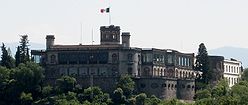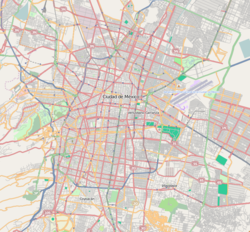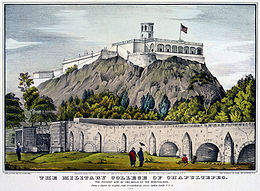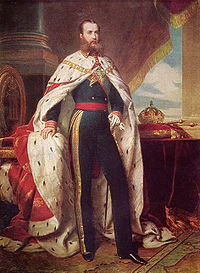- Chapultepec Castle
-
Chapultepec Castle Castillo de Chapultepec 
View of Chapultepec Castle from the EastGeneral information Architectural style Neo-romanticism, neoclassical, Neo-Gothic Location Mexico City, Mexico Coordinates 19°25′14″N 99°10′54″W / 19.42056°N 99.18167°W Elevation 2,325 metres (7,628 ft) above sea level Current tenants Museo Nacional de Historia Construction started c. 1785 Completed 1863 Height 220 feet (67 m) Design and construction Architect Eleuterio Méndez, Ramón Cruz Arango ity, Julius Hofmann, Carl Gangolf Kayser, Carlos Schaffer Other designers Maximilian I of Mexico Chapultepec Castle (Castillo de Chapultepec in Spanish) is located on top of Chapultepec Hill. The name Chapultepec stems from the Náhuatl word chapoltepēc which means "at the grasshopper's hill". It is located in the middle of Chapultepec Park in Mexico City at a height of 2,325 meters (7,628 ft) above sea level. The site of the hill was a sacred place for Aztecs, and the buildings atop it have served several purposes during its history; including that of Military Academy, Imperial residence, Presidential home, observatory, and presently, the Museo Nacional de Historia.[1]
It is the only Royal Castle in the American Continent, as well as the only one in North America that was used to house sovereigns: the Mexican Emperor Maximilian I, and his consort Empress Carlota, during the Second Mexican Empire.
Contents
Colonial period
In 1725 Viceroy Bernardo de Gálvez ordered the construction of a country house for himself at the highest point of Chapultepec Hill. Francisco Bambitelli, Lieutenant Colonel of the Spanish Army and engineer, drew up the blueprint and began the construction on August 16 of the same year.
After Bambitelli's departure to Havana, Captain Manuel Agustín Mascaró took over the leadership of the project and during his tenure the works proceeded at a rapid pace. Mascaró was accused of building a fortress with the intent of rebelling against the Spanish Crown from there. His sudden death on November 8, 1786, fueled speculation that he may have been poisoned; however no evidence has ever been found supporting this claim.,
Without an engineer in charge, the Crown ordered the building to be auctioned to a price equivalent to one fifth of the total already spent of the project. After finding no buyers Viceroy Juan Vicente de Güemes Pacheco de Padilla y Horcasitas intended the building to house the General Archive of the Kingdom of the New Spain; that idea was not to prosper either despite already having the blueprints adapted for this purpose.
Alexander von Humboldt visited the site in 1803 and condemned the sale of the palace’s windows by the Royal Treasury as a way of raising funds for the Crown. The building was finally bought in 1806 by the municipal government of Mexico City
Independence
Chapultepec Castle was abandoned during the Mexican War of Independence (1810–1821) and for many years later, until 1833. In that year the building was decreed to become the location of the Colegio Militar (Military Academy); as a sequence of several structural modifications had to be done, including the addition of the watchtower known as Caballero Alto ("Tall Knight").
On September 13, 1847, the Niños Héroes ("Boy Heroes") died defending the castle while it was taken by United States forces during the Battle of Chapultepec of the Mexican-American War. They are honored with a large mural on the ceiling above the main entrance to the castle [1].
The United States Marine Corps honors the Battle of Chapultepec and the subsequent occupation of Mexico City through the first line of the "Marines' Hymn," From the Halls of Montezuma. Marine Corps tradition maintains that the red stripe worn on the trousers of officers and noncommissioned officers, and commonly known as the blood stripe commemorates the supposedly high number of Marine NCOs and officers killed storming the castle of Chapultepec in 1847. However, evidence exists that red trouser stripes predated the battle, and the actual number of casualties is disputed.
Several new rooms were built on the second floor of the palace during the tenure of President Miguel Miramón, who was also an alumnus of the Military Academy.
Second Mexican Empire
The castle started to acquire its current look during the Second Mexican Empire, when Emperor Maximilian I of Mexico and his wife Empress Carlota chose it as their residence and the seat of their Court in 1864. The Emperor hired several European and Mexican architects, among them Julius Hofmann, Carl Gangolf Kayser, Carlos Schaffer, Eleuterio Méndez and Ramón Cruz Arango,[2] to design the several projects, which followed a neoclassical style and made the palace more habitable. European architects Kayser and Hofmann worked on several other revival castles, including Neuschwanstein Castle[3] – built by Maximilian's Wittelsbach cousin Ludwig II of Bavaria twenty years after Chapultepec's renovation.
Botanist Wilhelm Knechtel was in charge of creating the aerial garden located on the roof of the building. Additionally, the Emperor brought from Europe countless pieces of furniture, objets d'art and other fine household items that are exhibited to this day.
At this time, the castle was still located on the outskirts of Mexico City. Maximilian ordered the construction of a straight boulevard (modeled after the great boulevards of Europe, such as Vienna's Ringstrasse and the Champs-Élysées in Paris), to connect the Imperial residence with the city centre, and named it Paseo de la Emperatriz ("Promenade of the Empress"). Following the reestablishment of the Republic in 1867 by President Benito Juárez and the end of the Reform War (Guerra de Reforma) the boulevard was renamed Paseo de la Reforma.
Modern era
The castle fell into disuse after the fall of the Second Mexican Empire in 1867. Almost ten years later, in 1876, a decree established an Astronomical, Meteorological and Magnetic Observatory on the site, which was opened in 1878. However, the observatory was only functional for five years after it was decided to move it to the former residence of the Archbishop in Tacubaya. The reason was to allow the return of the Colegio Militar to the premises as well as transforming the building into the presidential residence.
The palace underwent several structural changes from 1882 and during the term of President Porfirio Díaz. The other Presidents who made the palace their official residence were Francisco I. Madero, Venustiano Carranza, Álvaro Obregón, Plutarco Elías Calles, Emilio Portes Gil, Pascual Ortiz Rubio and Abelardo Rodríguez. It was used for a time as an official guest house or residence for foreign dignitaries.
Finally on February 3, 1939, President Lázaro Cárdenas decreed a law that established Chapultepec Castle as the seat of the National Museum of History (Museo Nacional de Historia) with the collections of the former National Museum of Archaeology, History and Ethnography, (now the National Museum of Cultures. The museum was opened on September 27, 1944. President Cárdenas moved the official Mexican presidential residence to Los Pinos, and never lived in Chapultepec Castle.
In popular culture
- In 1996, the castle was a film location for the Academy Award-nominated movie William Shakespeare's Romeo + Juliet starring Leonardo DiCaprio and Claire Danes. Many views of the castle as the Capulet Mansion can be seen throughout the film.[4][dead link]
- In the 1954 American war film Vera Cruz starring Gary Cooper and Burt Lancaster, Chapultepec was portrayed using elaborate sets and decor.
- In the 2006 video game Ghost Recon: Advanced Warfighter, a level existed in and around the castle.
- Chapultepec Castle has been used as a model of castle architecture to design buildings such as the 13th Regiment Armory (Sumner Armory), in Bed Stuy, Brooklyn.[5]
Gallery
-
Monument to the Niños Héroes. Chapultepec Castle can be seen in the background.
-
View out of the Castle looking along the Paseo de la Reforma.
See also
- Chapultepec Park
- Paseo de la Reforma
- Palacio de Bellas Artes
- List of castles
References
- ^ http://www.mnh.inah.gob.mx/historia/hist_historicos.html
- ^ http://noticias.arquired.com.mx/shwArt.ared?idArt=218
- ^ http://eng.archinform.net/arch/3574.htm
- ^ http://www.corpseclothing.com/official_romeo__juliet_merchandise.html
- ^ http://www.brownstoner.com/brownstoner/archives/2009/05/walkabout_with_7.php?gallery1484Pic=4#gallery-1484
External links
Coordinates: 19°25′14″N 99°10′54″W / 19.42056°N 99.18167°W
Categories:- Imperial residences in Mexico
- Palaces in Mexico
- Landmarks in Mexico City
- Buildings and structures in Mexico City
- Castles in Mexico
- Official residences in Mexico
- Mexican monarchy
- Museums in Mexico City
- Royal residences in Mexico
- 1785 establishments
- 1785 in Mexico
- Cultural Sites on the UNESCO World Heritage Tentative List
- Nahuatl words and phrases
Wikimedia Foundation. 2010.














